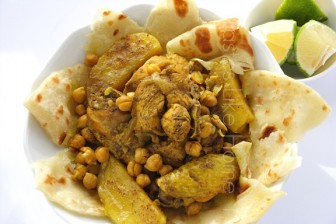Hi Everyone, Food never fails to surprise. You could have been eating a particular dish over and over again throughout your life and yet every time you eat it, new flavour dimensions are discovered. You forget how good it tastes; sometimes you wonder why you don’t make it often. It’s like re-discovering the dish for the first time. Thoughts and memories are reawakened; the food delights and yields new pleasures. And such was the case when I first ate Tashreeb Dijaaj.
Tashreeb Dijaaj is an Iraqi-styled dish of curried chicken that’s served with flat bread. It is cooked and prepared very much the same way we make curried chicken – sautéed with a spice paste and cooked in liquid until the meat is cooked and the liquid has reduced and thickened somewhat.
 You already know of my curry obsession, so of course when I read the recipe a couple of years ago I knew I had to try it. But guess what, it was not the different flavour profile of the curry that intrigued me, rather, it was the way in which the dish was eaten.
You already know of my curry obsession, so of course when I read the recipe a couple of years ago I knew I had to try it. But guess what, it was not the different flavour profile of the curry that intrigued me, rather, it was the way in which the dish was eaten.
You see here in the Caribbean we have two ways of eating curries with roti. Method one is to serve the curry in a plate or bowl with the roti on the side, either on a separate plate or perched on the edge of the plate. Some people are very picky in that they do not want the gravy to touch the roti until they are ready to eat it! That is why it in some cases, the roti is served from a separate vessel.
With this first method, a piece of the roti is torn, dipped into the gravy or dragged across the gravy and then eaten. Many people use each piece of roti to gather and transport morsels of chicken or other meat to the mouth. Their fingers clean – a marked sign of good eating etiquette in some households.
Method two requires that the curry be encased in the roti. The roti is first laid flat, the curry scooped in the middle of the roti and then the roti is folded over the curry. The curry and roti is then wrapped secure in wax paper or foil. This wrapping of the roti facilitates the eater to keep his or her hands clean and also to eat in stages as they carefully peel back the wrapper and bite into their roti with curry. This method is used most often by eating establishments that sell curry and roti.

The recipe for Tashreeb Dijaai instructed that I tear the roti into pieces and arrange it on the plate and then ladle the sauce over the roti as well as the chicken and potatoes and chickpeas (channa).
The author described the need to do this so that the roti can soak up all of the wonderful spice-flavoured gravy. She explained that this is the traditional way to eat the dish. To eat, take pieces of the gravy-laden roti with your bare hands and place it into your mouth. Take pieces of the meat and potatoes with your hands and sometimes with the sauced roti and eat it. This meant getting your fingers all messy with the sauce. At the end of the meal, you get to lick your fingers, or in-between bites like I did.
I had eaten curry and roti before but never like this. Having the roti soak up all the gravy gave the roti a different texture and mouth-feel.
Each piece of roti, pregnant with the curry gravy, made for pleasurable eating. Actually, I felt as if I did not need to eat the chicken or the potatoes because I felt completely satiated just eating the sauced roti. I knew I was eating curry and roti and yet it felt like I was eating something else. It was familiar and yet unfamiliar. That’s one of the surprising things about food. You can eat a dish repeatedly and then just change the way you eat it and have a totally different experience; a pleasurable one no less.
This way of eating the curry and roti made me think of dunking, the divisive method of eating that has its lovers and haters. Me, I am squarely on the lovers’ side of things. And then there are those that fall in between; they dunk, well, because that is the way that particular thing is designed to be eaten, for example, Biscotti, the famous Italian Cookie-biscuit. Biscotti is dry due to it being twice baked, and it must be dunked in some kind of beverage to soften it just enough so that you can bite into it easily.
It’s revealing to switch things up a little and let them surprise you, let them reveal dimensions you never knew, notes you never expected. Shake up the routine a little. Here are some combinations that are not new but perhaps you haven’t tried in a while.
> Eating Cook-Up Rice with Achar rather than pepper sauce.
> Eating Black Pudding with Achar rather than sour.
> Eating sweetbread (coconut bread) with cheddar cheese.
> Sprinkling sweet, ripe mangoes with salt before eating them.
> Pouring Punch de Crème over Christmas cake and then sopping up the Crème with the cake.
The next time you are making, serving or eating curry and roti, try having it the way I did – roti torn up and placed on plate, gravy, chicken etc ladled over roti and left to soak for about 2 minutes before devouring. I’m sure you’ll enjoy it. And don’t worry, there’s lots of soap and water to clean your hands when you’re done eating.
Cynthia
Cynthia@tasteslikehome.org
www.tasteslikehome.org




